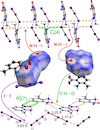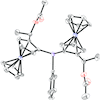issue contents
March 2021 issue

Cover illustration: Six new homochiral diferrocenyl derivatives have been synthesized, one of which is purely planar-chiral. Even if the two diferrocene subunits are identical, they are distinguished due to their positions relative to the substituents at the phosphorous prochiral centre. See Honegger, Roller & Widhalm [Acta Cryst. (2021), C77, 152-160].
scientific commentaries
 access
accessresearch papers






 access
access

 access
access



 journal menu
journal menu























